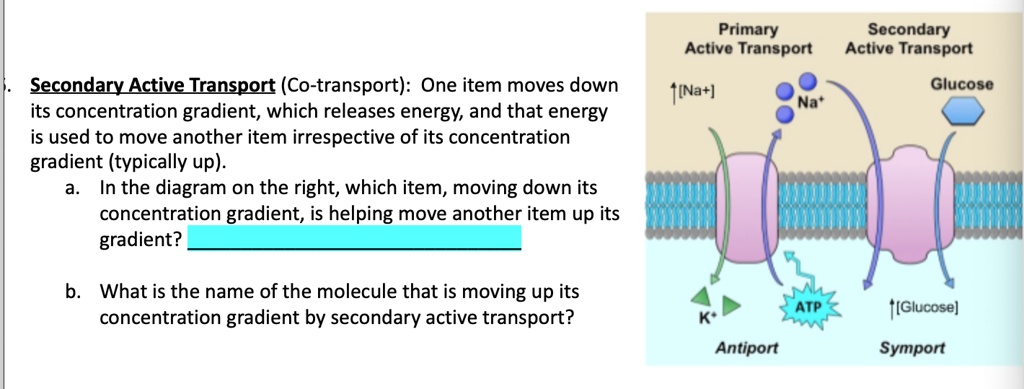Describe How Concentration Gradients Are Used in Cotransport
The classes differ in the types of. Cotransport is usually considered as secondary active transport.

2 1 2 Active Transport And Co Transport Flashcards Quizlet
When glucose molecules move into the cell by facilitated diffusion the concentration gradient plays an essential part.

. B How is cotransport used to move glucose into the intestinal epithelial cells. All the transport pumps have ATP binding sites on the cytosolic side of the membrane. However hydrogen ions can also be moved the other way toward areas of high concentration.
Cotransport transports proteins couple passage of one solute with passage of another Osmosis -the diffusion of water across a selectively permeable membrane --affected by solute concentration and pressure Water Potential -physical propery predicting the direction in which water will flow. To summarize it is the initial active transport of sodium through the basolateral membranes of the intestinal epithelial cells that provides the eventual motive force for moving glucose also through the membranes. -Cotransport is a substance pumped across a membrane and does work as it diffuses back across the membrane.
Instead another molecule is moved up its concentration gradient which generates an electrochemical gradient. They are directly using ATP to transport things against their concentration gradient which is why we call it active transport. Cotransport coupled transport The sodium-potassium pump is a specific protein in the membrane that uses energy in the form of ATP to exchange sodium ions Na for potassium ions K across the membrane.
Primary Active Transport Four classes of transport proteins function as pumps powered by ATP to bring about transportation against their concentration gradients. Basolaterally glucose exits the cell through facilitative glucose transporter 2 GLUT2 1. If a substance must move into the cell against its concentration gradient the cell must use free energy often provided by ATP and carrier proteins acting as pumps to move the substance.
A molecule is essentially trasported against its concentration gradient when its driven with an ion which can diffuse down its concentration gradient thorugh a specific transport protein. Now because you have these concentration gradients or these electrochemical gradients are established those can be used to do other forms of active transport. ATP breakdown is coupled to the transport of molecules by these pumps.
Facilitated diffusion uses integral membrane proteins to move polar or charged substances across the hydrophobic regions of the membrane. Describe the cotransport system that does this and include the different energy transformations that occur for the energy that started in ATP. While this process still consumes ATP to generate that gradient the energy is not directly used to move the molecule across the membrane hence it is known as secondary.
The unequal balance of Na and across the membrane creates large concentration gradients that can be used to drive transport of other substances eg. The concentration gradient will then cause these proteins to facilitate the diffusion of other molecules down their gradient. A type of secondary active transport across a biological membrane in which a transport protein couples the movement of an ion usually Na or H down its electrochemical gradient to the movement of another ion or molecule against a concentration or electrochemical gradient.
One molecule is moving down its concentration gradient in a passive manner for carrying a. Unlike in primary active transport in which ATP hydrolysis provides the free energy needed to move solutes against a concentration gradient in secondary active transport the free energy needed to perform active transport is provided by the concentration gradient of. When a hydrogen ion passes down the concentration gradient through a transporter it makes that potential energy available.
Glucose only enters the cell by diffusion if its intracellular concentration is lower than the extracellular one. And thats what we call secondary active transport. Substances that move across membranes by this mechanism a process called active transport include ions such as Na and K.
Cotransport is driven by active sodium extrusion by the basolateral sodiumpotassium-ATPase thus facilitating glucose uptake against an intracellular up-hill gradient. Galactose is transported by almost exactly the same mechanism as glucose. Connection for AP Courses.
Transport of many solutes drive by a proton gradients. Co-transport can occur also with different molecules and in different locations but the principle is basically the same. -Substances diffuse down their concentration gradient without using energy.
The coupled transport of chemical substances across a cell membrane in which the energy required to move a substance such as glucose against a gradient in concentration or in electrical potential is provided by the movement of another substance such as a sodium ion along its gradient in concentration or in electric potential The sodium-linked. Describe the freeze fracture technique and why is it useful in cell biology. ATP is used to drive the movement of sucrose up its concentration gradient and into the cell.
Absorption of Other Monosaccharides. The molecule of interest is then transported down the electrochemical gradient. This energy can be used to take a molecule from inside the cell and move it out or can help make ATP in a specialized enzyme.
Active transport indirectly requires energy from the hydrolysis of ATP. Up to 24 cash back Cotransport is a type of membrane protein that is dependent on other protein pumps to create a concentration gradient. A concentration gradient exists that would allow ions and polar molecules to diffuse into the cell but these materials are repelled by the hydrophobic parts of the cell membrane.

Secondary Active Transport Physiologyweb

Solved Primary Secondary Active Transport Active Transport Secondary Active Transport Co Transport One Item Moves Down Its Concentration Gradient Which Releases Energy And That Energy Is Used To Move Another Item Irrespective Of Its Concentration

No comments for "Describe How Concentration Gradients Are Used in Cotransport"
Post a Comment